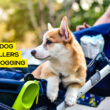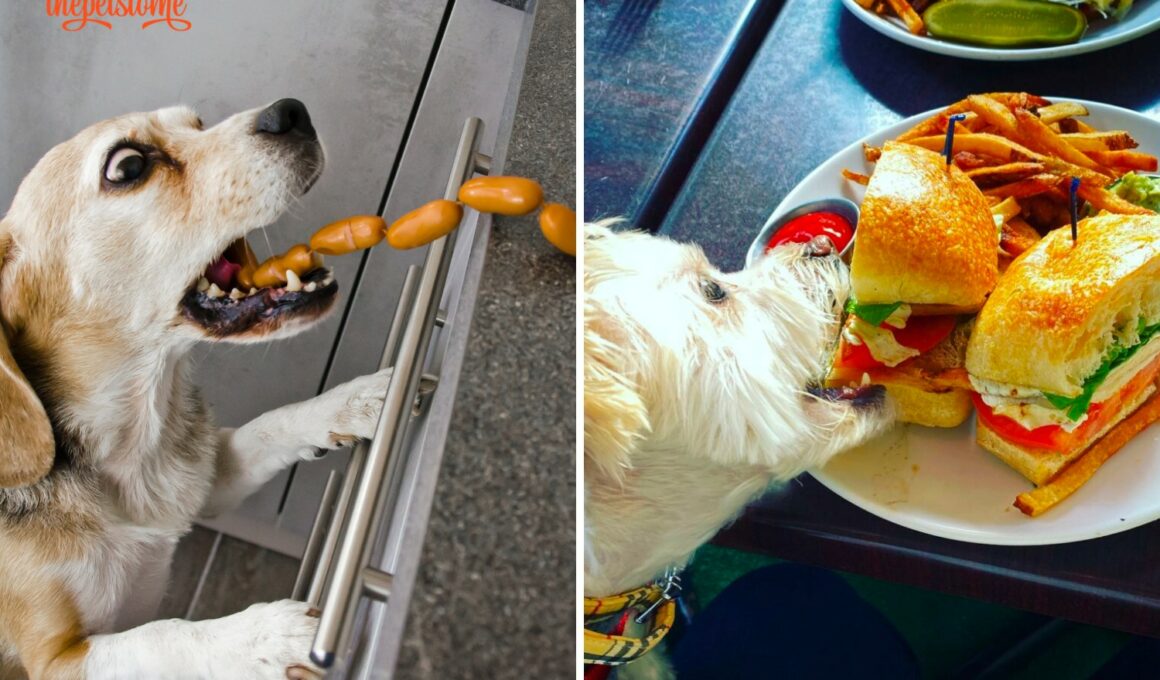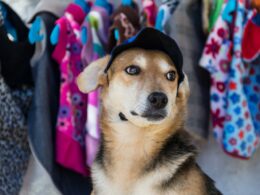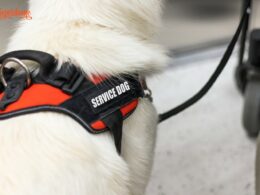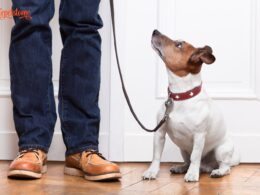Table of Contents Show
Ah, dinner time—a moment of peace after a long day, where we can finally indulge in a delicious meal. If you’re a dog parent like me, though, you know that sometimes, it’s not just you eyeing that plate.
It’s your furry friend too, plotting their master plan to sneak a bite. And believe me, I’ve seen it all over the years—from the stealthy stares to the innocent table bumps. It’s all part of their adorable, cunning playbook.
Today, I’m diving into the “7 Signs Your Pooch is Plotting to Steal Your Dinner.” Because let’s face it: when it comes to food, our dogs can be little schemers, and it’s essential to recognize the signs for a more harmonious mealtime. So, fellow dog enthusiasts, let’s get into these cheeky behaviors together!
7 Signs Your Pooch Is Plotting to Steal Your Dinner
Dogs too can be witty and has outsmarted their owners countless times. To better understand what trick your dog has sleeve up when it comes to hijacking your food, I have compiled the 7 signs to look out for;
1. The Stealthy Stare
We’ve all experienced it. You’re about to take that first bite when you feel a pair of eyes drilling into you. Glancing down, you lock eyes with your pooch, who’s giving you that unwavering, intense stare. It’s not just a regular look—it’s the look. The one that seems to say, “That sure smells nice, doesn’t it?”
But what’s going on in that furry head of theirs? Let’s dig into the doggy psychology for a moment. Dogs, as descendants of wolves, are instinctively observant predators. In the wild, their survival largely depended on their ability to focus intently on potential prey or food sources.
This ‘hunting stare’ has, over time, evolved in our domesticated buddies into what I lovingly refer to as the ‘dinner plate gaze’. It’s a combination of their ancestral instincts and their learned behavior that staring might just get them a tasty reward. After all, who hasn’t slipped their dog a treat now and then in response to that intense gaze?
Moreover, dogs are exceptionally adept at reading human body language. They’ve mastered the art of gauging our reactions, and they know that sometimes, just sometimes, that unwavering attention might make us cave and share a morsel.
So, the next time your pup gives you the stealthy stare, remember—they’re tapping into age-old instincts and cleverly playing their cards right!
2. The Strategic Positioning
If you ever thought your dog’s choice of lounging spot during mealtime was random, think again. Our canine companions have turned the art of positioning into a strategic game, and they’re playing to win (or at least, win a bite or two).
First, let’s talk about the classics. The spot is right under the table or directly beside your chair. From this vantage point, your pooch has a clear view of every move you make, every morsel you drop, and, most importantly, every opportunity to make a stealthy snatch.
This location isn’t just about convenience; it’s about being at the epicenter of potential food drop. Plus, being close means they can quickly shoot you their best puppy dog eyes or nudge your hand with a wet nose, reminding you of their presence.
But then, there’s the “casual” approach. This is for the more subtle pooches out there. They might lie down a bit farther away, seemingly disinterested in your meal. But make no mistake; they’re still watching.
Every so often, they might stretch, reposition, or even give out a seemingly random yawn. However, their ears twitch at the sound of a fork drop, or their nose twitches with the waft of your dish. This approach is all about playing it cool while still being alert to any food opportunities.
Contrastingly, there’s the “direct” approach, which is more in-your-face. These dogs don’t bother with subtlety. They might sit upright, eyes fixed on your plate, tail wagging in hopeful anticipation. Every so often, they might inch closer, testing the waters to see how near they can get before you notice.
So whether it’s the casual observer or the direct petitioner, dogs have their ways of positioning themselves in the prime real estate of dinner opportunities. It’s a blend of instinct, experience, and just a pinch of hopeful optimism. After all, in their minds, the next bite could always be theirs!
3. The Fake Sleep
One of the sneakiest (and arguably, most endearing) tactics in the doggy dinner-theft playbook is the classic “fake sleep.”
As dog parents, we often underestimate just how clever our canine companions can be. But, let me tell you, when it comes to securing a tasty treat, they can pull off some award-winning performances.
Imagine the scene: you’re enjoying your dinner, and you glance over to see your pup seemingly fast asleep, perhaps even snoring softly. You think, “Aw, how peaceful!” and mentally note how you won’t be bothered during this meal.
But here’s the twist—amidst that peaceful slumber, one eye is slightly ajar, covertly monitoring every bite you take. It’s their undercover mode: giving the illusion of deep sleep while staying vigilant for any chance to snatch a bite.
But what’s truly impressive about the “fake sleep” maneuver is the lightning speed at which these pretend-sleepers can spring into action.
One moment, they’re in the land of dreams, and the next, they’re right beside your plate, all thanks to the faintest sound of a food item dropping or the subtle shift of your chair. It’s a transition so swift, it would put Olympic sprinters to shame!
This tactic showcases not just the cunning nature of our pups but also their sheer determination.
They’re willing to feign total disinterest, lull us into a false sense of security, and then strike when we least expect it. It’s a gentle reminder that, sometimes, even when they appear to be in dreamland, they might just be dreaming of the delectable dish on your plate!
4. The Distraction Technique
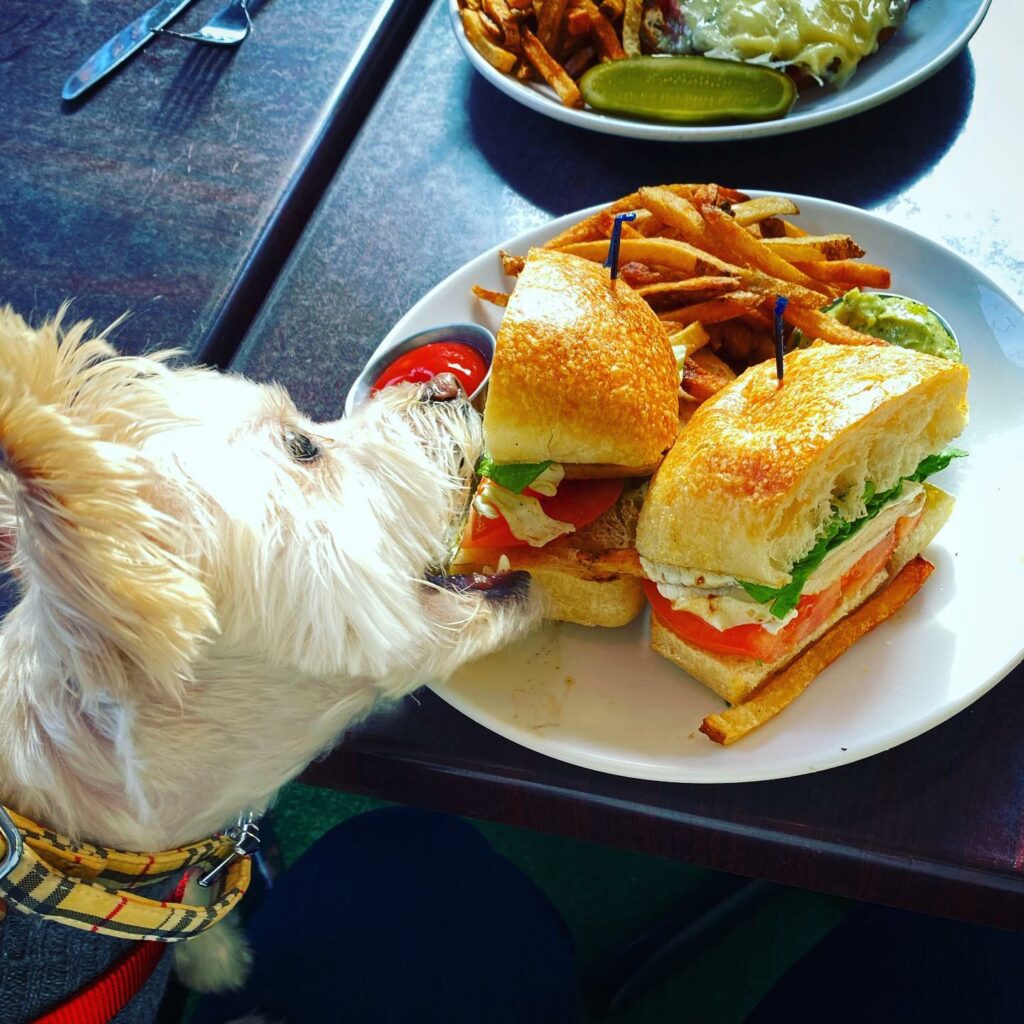
Oh, the lengths our fur-buddies will go to get a taste of our meals! Among the many tricks up their furry sleeves, the distraction technique is one that particularly stands out for its sheer audacity and cleverness.
Picture this: you’re halfway through your meal, deeply engrossed in the flavors dancing on your palate. Suddenly, there’s a loud bark, or perhaps the sound of something crashing in another room.
Your immediate instinct is to jump up and check out the ruckus, right? But when you return, a piece of your dinner mysteriously seems to have vanished. Coincidence? Not likely. Dogs are incredibly perceptive creatures. They quickly pick up on patterns and can associate certain reactions with specific behaviors.
So, if they’ve noticed that causing a scene diverts your attention away from your plate, even if it’s for a few seconds, they might use it to their advantage.
Barking at an imaginary squirrel outside or knocking over a vase can be their version of a magic trick—while you’re focused on the distraction, they swiftly grab their prize.
Now, while we might chuckle and admire their creativity, it’s crucial not to let such behaviors become a habit. The key is consistency in training. If your dog resorts to naughty antics during meal times, correcting them immediately and consistently is essential.
Reinforce good behavior with positive rewards and establish boundaries. By doing so, you are ensuring peaceful meal times for yourself and promoting good manners and discipline in your pup.
Remember, indulging them once or twice might seem harmless, but it could set a challenging precedent to reverse. After all, we want to appreciate their intelligence without encouraging mischief!
5. The Sudden Show of Affection
There’s no denying it; dogs are affectionate creatures. Those random bursts of love, the nuzzles, the licks—they melt our hearts.
But let’s be real: sometimes, these affectionate displays conveniently occur when we’re savoring a mouth-watering steak or digging into a slice of pie. Is it genuine love or a calculated move? Let’s explore.
You’re seated at the dining table, your plate laden with deliciousness. Out of the blue, your typically independent pooch saunters over, offering you the gentlest of licks or resting their head on your lap, giving you those irresistible doe eyes.
It’s hard not to feel special, right? But wait a minute! Isn’t this the same little furball that was too busy with their toys just a moment ago?
Here’s the tricky part: Dogs, with their innate ability to read human emotions, have a knack for understanding just when to turn on the charm. They realize that during meals, humans are in a relaxed state, more susceptible to their displays of love.
And while many of these actions stem from their genuine love and bonding instincts, there’s no harm in them trying to get a tasty reward out of it, is there? It’s their way of saying, “Hey, I love you, but that chicken does smell pretty tempting.”
So, how do we discern between genuine affection and strategic buttering up? The lines are admittedly blurry. But as seasoned dog parents, we can pick up on the cues. If these sudden shows of affection are a recurring theme exclusively during meal times, there’s a good chance it’s a mix of both genuine love and a dash of opportunism.
The takeaway here? Cherish and reciprocate their affection (because let’s face it, dog cuddles are the best), but remain mindful of their sneaky intentions.
By setting boundaries, you can reinforce good behavior without dampening their loving spirit. After all, it’s all about balancing love, discipline, and the occasional treat!
6. The Silent Begging Whine
For those of us with a keen ear and a deep bond with our four-legged friends, the subtle nuances in their vocalizations are familiar territory. Among the myriad of barks, yips, and growls, there lies a particularly heart-tugging sound—the silent begging whine. It’s so soft, so fleeting, that if you weren’t paying close attention, you might miss it. But to the trained ear, it’s a poignant plea: “Can I have some, please?”
This almost inaudible whimper is a masterclass in canine communication. It’s not the loud, demanding bark nor the persistent, attention-seeking whine. Instead, it’s a gentle, understated appeal, often paired with those wide, imploring eyes. It’s as if your dog is saying, “I don’t want to disturb you, but if you could spare a bite, I’d be ever so grateful.”
But here’s where it gets interesting: not all whines are created equal. So how do we, as dog parents, differentiate the silent begging whine from other whines?
Context is Key
If this soft whine emerges predominantly during your meal times, there’s a high likelihood it’s their way of politely asking for a share.
Physical Cues
Pairing the whine with certain behaviors can give away its intent. The silent begging whine often comes with those pleading eyes, a slight tilt of the head, and sometimes even a gentle pawing at your leg.
Duration and Intensity
Unlike distress or discomfort whines which might escalate in volume or persist for extended periods, the silent begging whine is typically short-lived and subdued. It’s as if they’re trying their luck, but don’t want to be too pushy.
Response to Comfort
If you comfort your dog without offering food and the whining stops, it might have been a general call for attention. But if the soft whine continues even after some petting, it’s probably food-driven.
In the grand scheme of dog communication, the silent begging whine is just one thread, but it’s a testament to the depth of their emotional intelligence and their innate ability to connect with us.
While it’s endearing, it’s also essential to maintain boundaries. A treat here and there is lovely, but ensuring our dogs maintain healthy eating habits is paramount. Remember, understanding is the first step to a happy coexistence with our furry family members!
7. The Accidental Table Bump
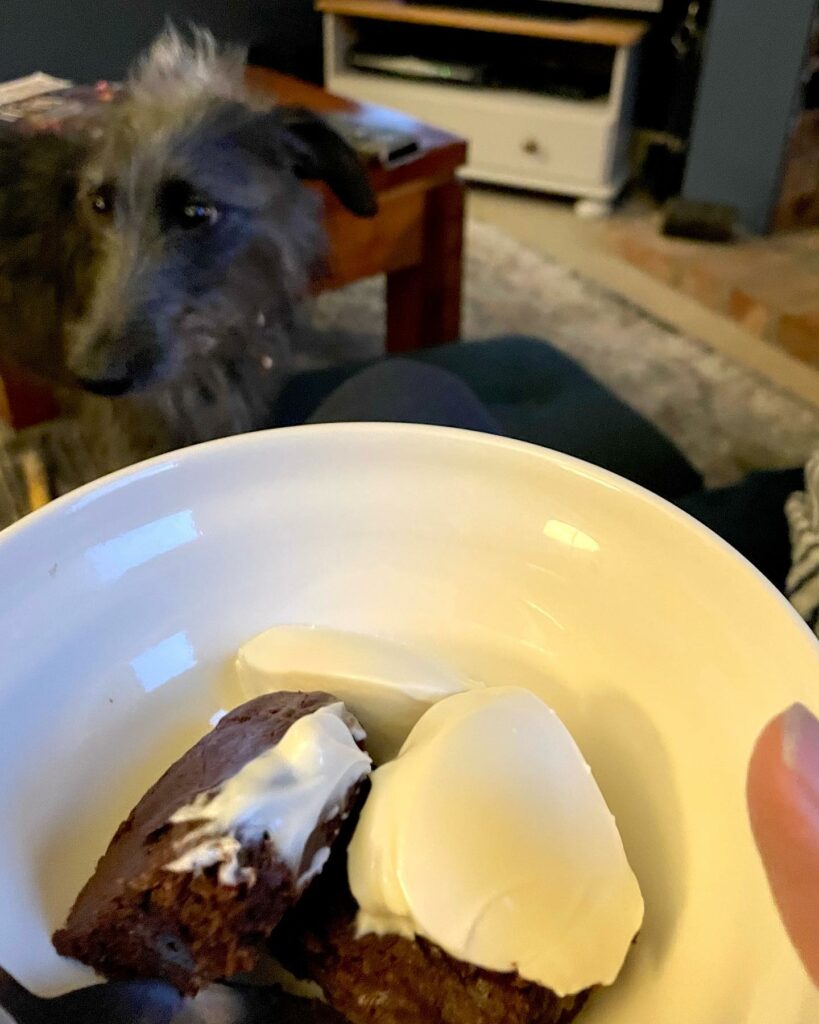
Ah, the “accidental” table bump—a maneuver so sly, it often leaves us wondering if it was indeed a mere accident or a well-thought-out strategy.
If you’ve ever been in a situation where your dog seemingly “innocently” bumped into the table, sending a few crumbs (or even an entire meal) crashing to the floor, then you’ve witnessed this crafty tactic firsthand.
Let’s set the scene: you’re enjoying your dinner, your furry companion conspicuously nearby. Suddenly, there’s a gentle nudge against the table’s leg, a quick shift of your plate, and voila—your dinner is now an open buffet on the floor.
As you’re processing the event, your pooch is already feasting on the unexpected bounty, looking up only to give you an “Oops, did I do that?” expression.
It’s a tactic that plays on their knowledge of gravity and our reactions. They’ve learned that things that fall are fair game, and what better way to get a direct serving than to “accidentally” hasten the process?
However, while we might chuckle at their antics, ensuring this doesn’t become a routine is crucial. Here are some training techniques to reinforce good behavior:
Boundary Training
Begin by teaching your dog a “stay” or “place” command, directing them to a designated spot away from the dining area during meals. Over time, this reinforces the idea that the dining space is off-limits during meal times.
Immediate Correction
If they do bump into the table, offer a firm but gentle “No” or “Uh-uh.” It’s essential to correct the behavior as it happens, ensuring they associate the action with the reprimand.
Reward Positive Behavior
Whenever your dog respects boundaries and stays away from the table during meals, reward them with praise or a treat. Positive reinforcement is often more effective than punitive measures.
Stability Measures
Consider using non-slip placemats or heavier dishes that aren’t easily toppled. While this doesn’t address the behavior directly, it can prevent food spills, making the table bump less rewarding.
Consistent Rules
Ensure everyone in the household is on the same page regarding feeding and table etiquette. Mixed signals from different family members can confuse your dog and reinforce unwanted behaviors.
At the end of the day, our dogs are ever-curious and opportunistic beings. While their sneaky strategies can be amusing, it’s our responsibility to guide them toward behaviors that ensure harmony in the household. After all, a well-trained dog is a happy dog—and a happy dog means a happy home!
Conclusion
In the delightful world of dogs, their crafty dinner-time tactics never cease to amaze. From the unmistakable stealthy stare to the oh-so-innocent table bump, our pooches have a playbook all their own.
As we’ve journeyed through these signs, one thing becomes clear: while their antics are undeniably charming, setting clear boundaries is crucial for a peaceful coexistence at the dining table.
But hey, we’ve only scratched the surface here. Fellow dog parents, what sneaky moves have your pups pulled off?
Have you discovered some foolproof training tips? Share your stories and strategies in the comments below. After all, in this delightful dance between pooches and plates, we’re all in it together!



